Become an elf or troll, cultivate fields, raise livestock and dig caves 'Caverna: Forgotten Tribes' Review

'Caverna: Forgotten ' is an extended version of the
Kaverna: Forgotten Tribe | | ANALOG GAME INDEX
http://hobbyjapan.games/caverna_tff/
You can see how to play the basic set 'Caverna: Cave Farmers' in the article below.
Review of 'Cavellna: Cave Farmers', a board game based on a miniature garden where the whole family develops farmland and caves --GIGAZINE

The package of 'Caverna: Forgotten Tribe' looks like this. The designer is Uwe Rosenberg, the creator of the popular board game ' Agricola', as in the basic set.
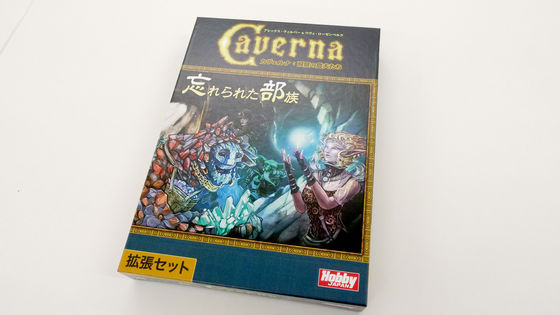
The number of players is 1 to 7, the playing time is the number of players x 30 minutes, and the target age is assumed to be 12 years old or older.

'Caverna: Forgotten Tribes' is an expansion set, so you need the basic set 'Caverna: Cave Farmers' to play.

Inside was a rule manual and a bag to store panels and tokens.
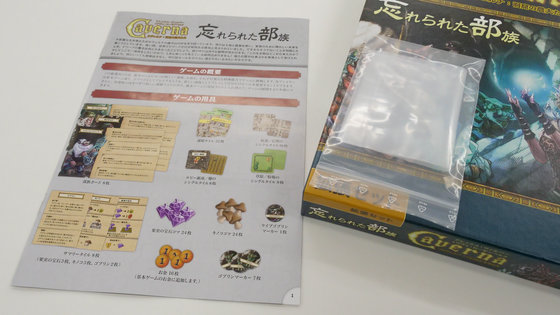
And cardboard containing each panel and tokens.
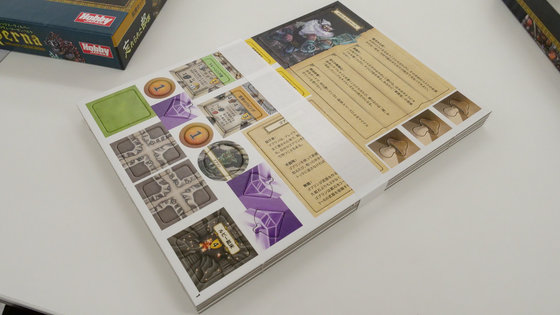
The cardboard has a notch so you can easily remove it without scissors or a utility knife.
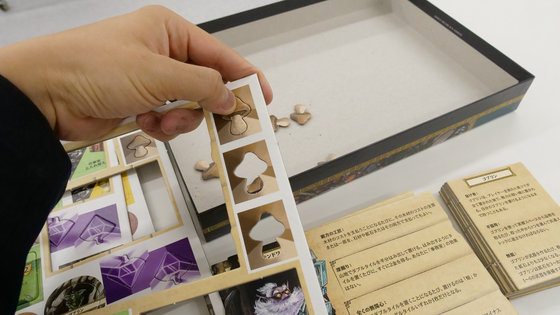
I removed all the panels and tokens.
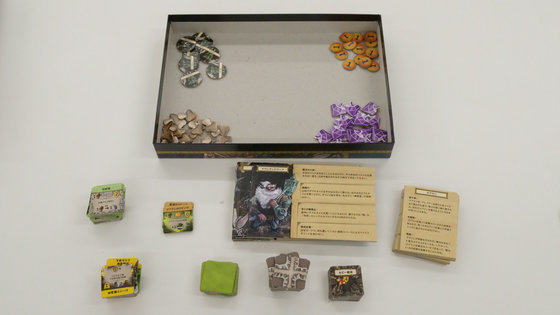
A major feature of 'Caverna: Forgotten Tribes' is that you can select and play eight races with different abilities. If you want to play with 4 players, distribute 2 tribal panels and choose 1 of the 2 panels.
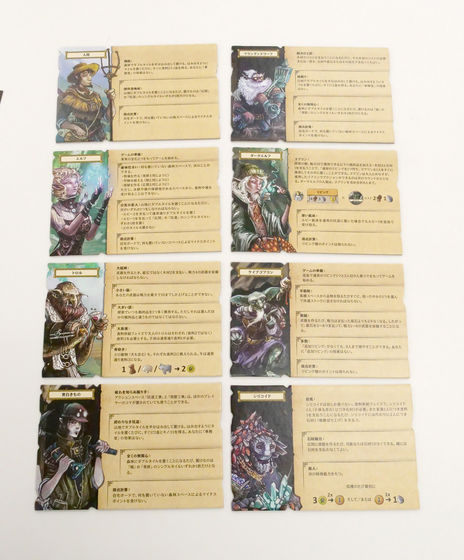
In addition, each tribe has room panels that correspond to the skills of each tribe ...
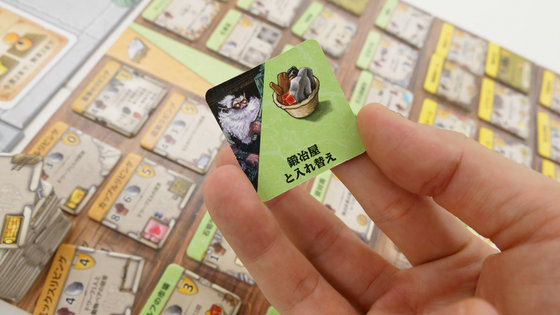
Place it in place of the room panel in the basic set.
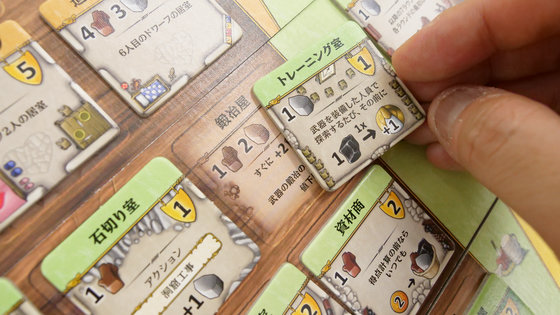
After that, just like the basic set, place tokens, action panels, action card decks, and player boards, and you're ready to go. The way to proceed with the game is exactly the same as the basic set.
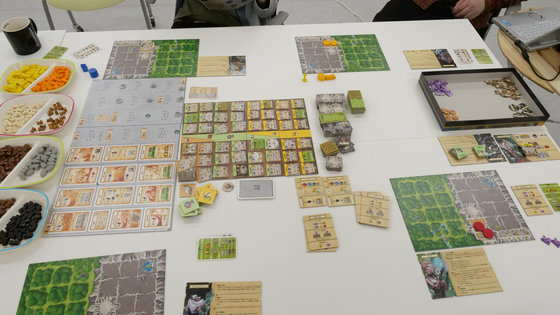
There are advantages and disadvantages to the skills provided by each tribe. For example, in the case of mountain dwarves, the skills of 'you can pay the cost of wood with stone or ore' and 'you can place two double tiles in the mountains outside' are very powerful, but 'double tiles in the forest'. There is also a restriction that 'it cannot be placed and only a single tile can be placed'.
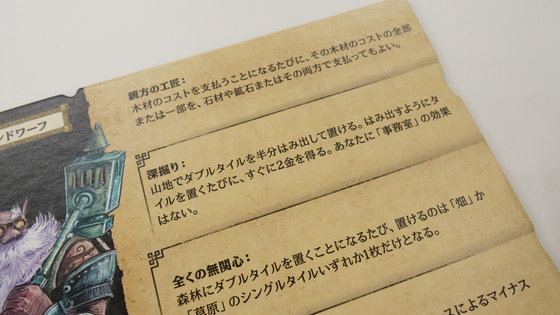
'Mine construction' can get double tiles that can be placed in the cave part. Place a disc-like dwarf token and get two stones.

Originally, you have to arrange the double tiles so that they fit within the frame, but with the skill of mountain dwarves, you can arrange them so that they stick out as follows. If you place the tiles outside, you will get 2 gold that can be exchanged for food and items.

You can also pay for wood in stone or ore, which makes it easier to control the cost of setting up a room.

With that feeling, it is possible to dig a cave and make a room. However, due to the limitation that double tiles cannot be placed in the forest, the forest on the left side of the player board will not be cultivated at all.
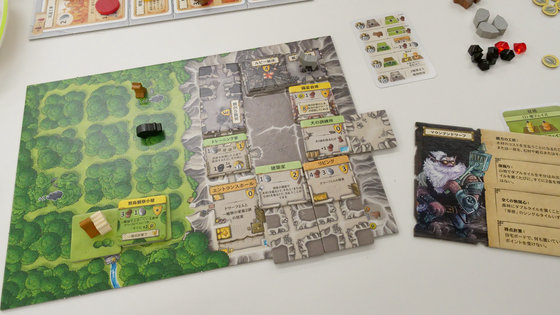
After exploring the cave and creating a large amount of deposits, we will set up a 'director's living room' where you can get ore and rubies according to the adjacent deposits in the place where the ruby deposits are adjacent in three directions.
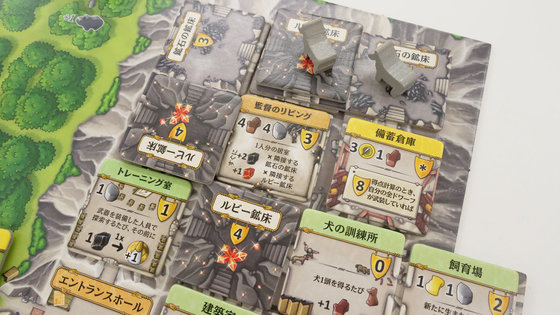
Ruby is a resource that can be converted into food, livestock, and panels. Since we are digging mainly in caves, it is difficult to secure crops and livestock, so we will start a strategy to make ends meet using rubies.

Use the action panel to dig up rubies more and more ...

We will convert it into food and insufficient materials.

As usual, the forest is almost untouched, but we raise a pair of cows on a ranch where we made only one square.

In addition, a 'breeding ground' where food can be added each time an animal is born has been set up in the overhanging plaza.
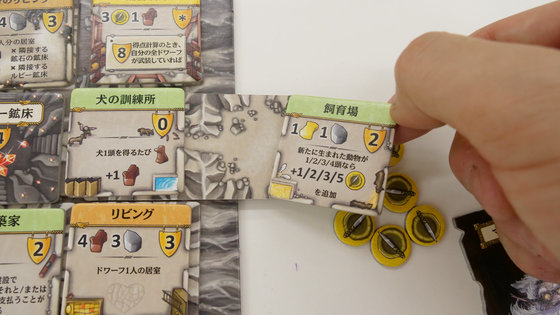
Since the cows raised in the woods give birth to one child at the end of the round, the effect of the calves born and the room will give a total of 4 foods, and the food situation has become more stable.
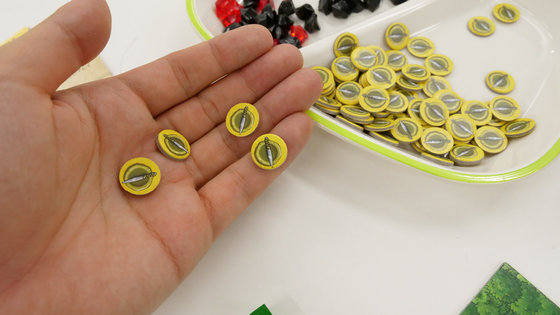
The opposite player is the exact opposite of the Mountain Dwarf, playing as a 'human' with the skill 'You can place double tiles in the forest, but you can't place double tiles in the mountains.' Suddenly, when I looked at the panel, ranches and fields were set up in the forest, and I became a farmer and livestock farmer who continued to produce crops and livestock.
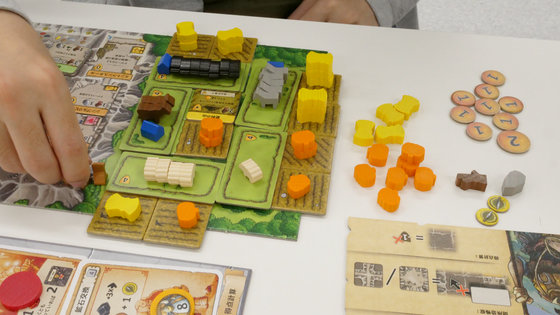
Since the rules have already been grasped by playing in the basic set, the game progresses smoothly, and the game ends in about 2 hours and 30 minutes including grasping the new rules.
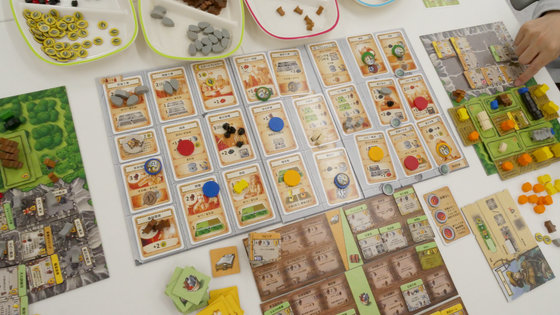
Finally, the score is calculated. Originally, 1 point is deducted for each untouched place where tiles and tokens are not placed, but since Mountain Dwarves have the skill that 'Forests are not deducted even if they are untouched', there is no deduction. Mountain dwarves are characters that can be played with only cave reclamation in mind.
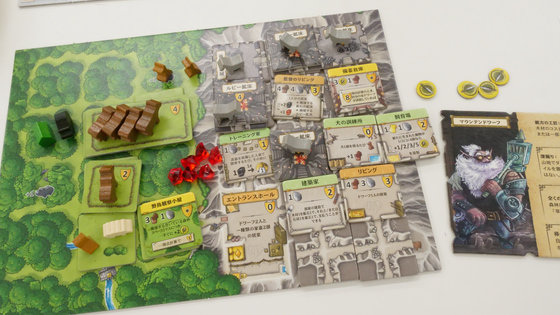
The player who earned the most points was the 'human' who was growing a large amount of crops and livestock.
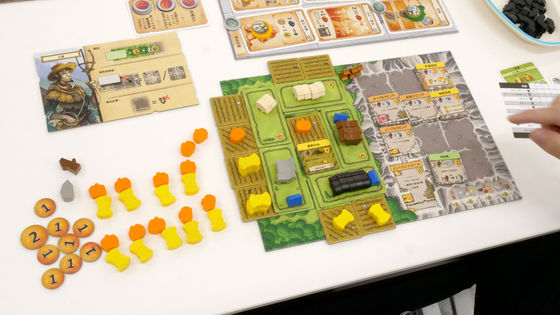
The farm is crowded with sheep and wild boars ...
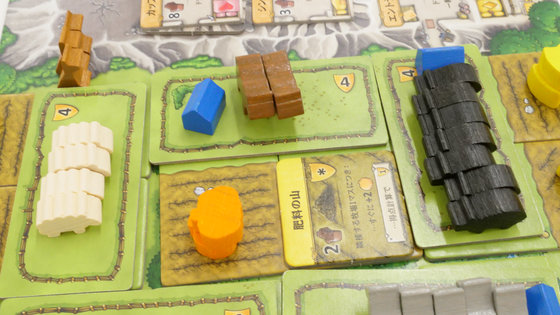
In addition, there was a 'storage room' that could be converted into 2 victory points by combining 1 wheat and 1 vegetable.
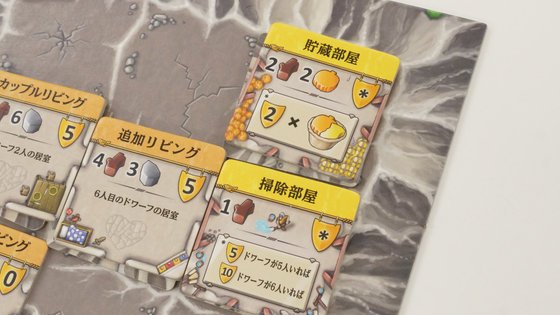
Due to the effect of the storage room, a large amount of crops became a high score source as it was, which was the decisive factor for victory.
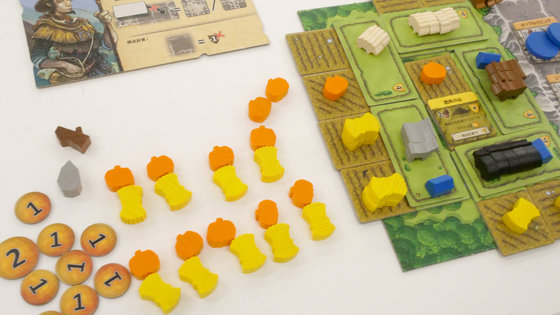
Elves living in nature are a race that says, 'You can plant crops without clearing forests, but you have to pay rubies to place tiles in the mountains.'

Since the elf has to pay the ruby as a cost when cultivating the cave, it will inevitably develop around the forest, but food can be obtained for every three empty forest spaces. I couldn't cultivate the forest well because of the effect of 'Hunter's Hut', and the score did not increase. In addition, the double tile of the field and the grassland is placed in the lower right of the forest, but in the first place, the elf can plant crops instead of the field, and can make a ranch without turning the forest into a grassland, so the turn that took this Has become almost meaningless.
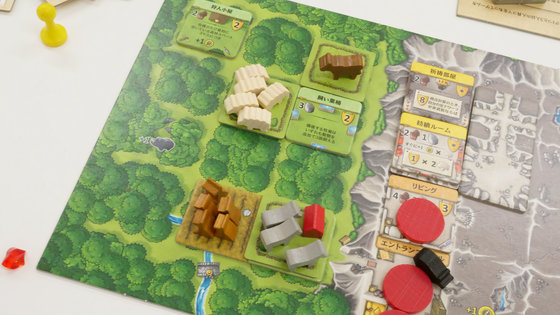
In the next game, select Troll.

Warlike trolls have the skill of being able to arm dwarves, who would otherwise have to pay for ore, with just two pieces of wood. However, because of its low intelligence, it also has the disadvantage that the armed level can only be raised to 10 at the maximum.
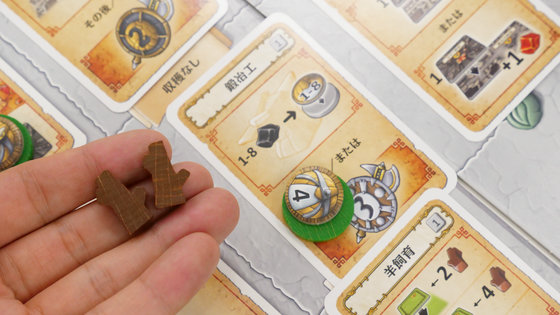
Also, trolls have a very strong appetite. Normally, you would have to pay 2 foods per body for each round, but since trolls need 3 foods per body, you have to devote a lot of resources to securing food anyway. However, trolls with advanced animal dismantling technology can convert all livestock into food. Trolls can convert sheep and donkeys, which normally can only be converted to 1 food, into 2 foods. Also, dogs that cannot be used as food can be converted into 2 foods. As a result, the gluttonous troll frequently sacrificed animals while muttering 'Dog because of lack of food ...' during the game.
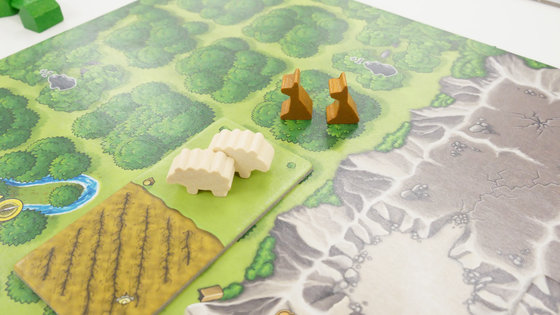
Inevitably, raising a lot of animals is an important means of securing food for trolls. Therefore, we set up a room called 'Bone Processing Plant' where you can get 3 gold for every 2 animals.
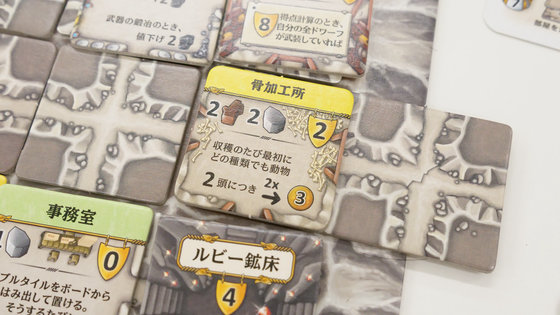
Furthermore, paying attention to the fact that the ore is no longer needed for armament and the ore is messed up, we have set up an 'ore warehouse' that can convert the ore into victory points.
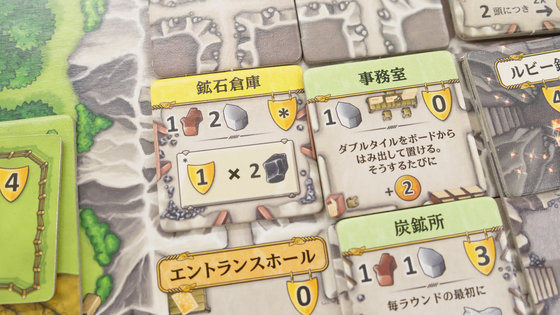
Food supply is stable and money and ore are piled up.
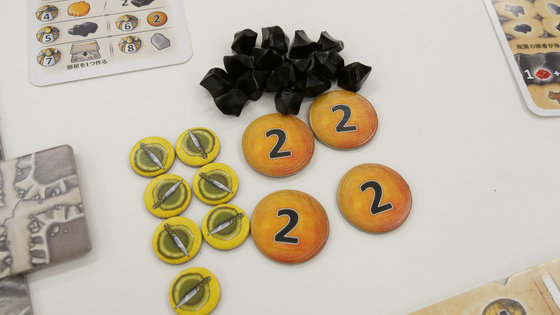
The troll player board, which finished the game in about two hours, looks like this. Too desperate to secure food and ore, the forest reclamation was delayed, and 8 squares were left untouched, resulting in a deduction of 8 points. However, since the money and ore that had been steadily saved were converted into victory points as they were, the deductions were successfully recovered.
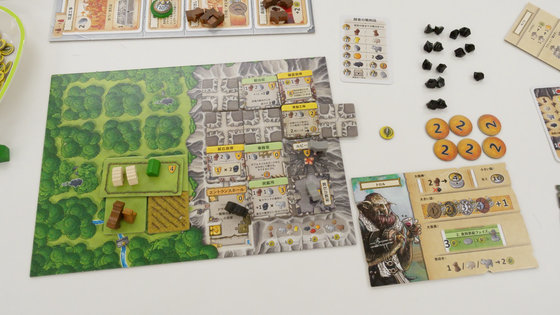
The player who got the highest score plays with the 'blue and white thing' of the tribe living in the cave. The pale ones have almost the same skills as the Mountain Dwarves, but ...
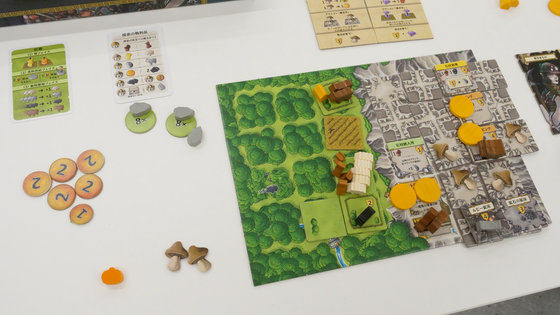
A major feature is that mushrooms can be cultivated as crops in the cave. The pale ones can be farmed in the cave instead of limiting the development of forests, which solves the food problem.
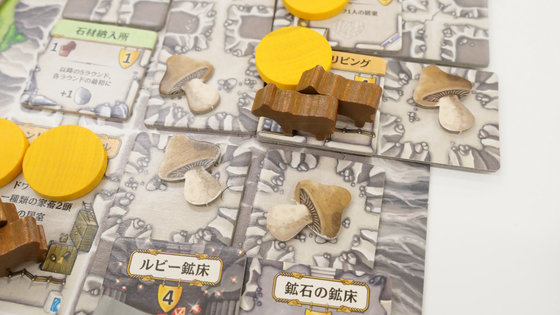
'Caverna: Forgotten Tribe' is exactly the same as the basic set in terms of the rules of the game. However, based on the unique skills of each tribe, think about 'in what direction to play', 'I want to dig a cave and play', 'I want to grow a lot of crops and livestock anyway', 'I want to increase the number of people and search. You need to select different play styles such as 'I want'. In the basic rules, there were a lot of places to check and thoughts, but in 'Kaverna: Forgotten Tribes', the play style was narrowed down by the skills of each tribe, making it easier for even unfamiliar people to play.
This time, after the player selected a tribe, he was able to play smoothly by turning the tribe panel and the corresponding room panel to check what skills other tribes have. Therefore, it is necessary to know in advance what skills each tribe has.
'Caverna: Forgotten Tribe' can be purchased at Amazon.co.jp for 2500 yen including tax.
Amazon | Caverna: Forgotten Tribes Japanese Version | Board Games | Toys

Related Posts:






